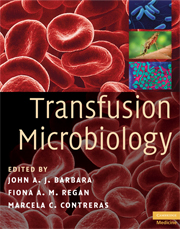Book contents
- Frontmatter
- Contents
- List of contributors
- Foreword
- Preface
- Acknowledgements
- Glossary
- Introduction: Transfusion-transmitted infections, then and now
- Section 1 Agents
- Section 2 Selection and testing
- 10 Blood donor selection and qualification
- 11 Current serological methods of testing and automation
- 12 Confirmatory testing and donor re-admission
- 13 The strategy for applications of nucleic acid testing
- 14 Nucleic acid testing: general view
- 15 Nucleic acid testing: the US approach
- 16 Nucleic acid testing: the UK approach
- 17 Quality in the screening of donations for transfusion-transmissible infections
- 18 Microbiological blood testing and new technologies
- 19 Processing and components: leucodepletion and pathogen reduction
- 20 Fractionated products
- Section 3 Surveillance, risk and regulation
- Index
- Plate section
- References
13 - The strategy for applications of nucleic acid testing
from Section 2 - Selection and testing
Published online by Cambridge University Press: 12 January 2010
- Frontmatter
- Contents
- List of contributors
- Foreword
- Preface
- Acknowledgements
- Glossary
- Introduction: Transfusion-transmitted infections, then and now
- Section 1 Agents
- Section 2 Selection and testing
- 10 Blood donor selection and qualification
- 11 Current serological methods of testing and automation
- 12 Confirmatory testing and donor re-admission
- 13 The strategy for applications of nucleic acid testing
- 14 Nucleic acid testing: general view
- 15 Nucleic acid testing: the US approach
- 16 Nucleic acid testing: the UK approach
- 17 Quality in the screening of donations for transfusion-transmissible infections
- 18 Microbiological blood testing and new technologies
- 19 Processing and components: leucodepletion and pathogen reduction
- 20 Fractionated products
- Section 3 Surveillance, risk and regulation
- Index
- Plate section
- References
Summary
Although blood transfusion is appropriately considered a lifesaving procedure it remains, as has been recognized for more than six decades, a procedure which carries risks of transmission of infection from donor to the recipient. These risks are best considered in terms of first, the administration of a (usually) small number of discreet whole blood units, and second, blood components, that is, the practice of blood transfusion, as compared with the replacement of a deficient plasma constituent by a blood product containing material from many, often thousands of donors, which has been purified from a starting plasma pool, that is, the use of a blood product. The essential mantra for transfusion safety remains first, ‘know your donor’ and second, ‘test your donor’. Both are essential for the safety of blood and blood components which remain difficult to subject to terminal product sterilization. For blood products, on the other hand, the operational side of manufacture has led to derogation of ‘know your donor’ in favour of ‘test your donor’ and paradoxically it is in this area that the application of nucleic acid testing (NAT) has had most impact. This is perhaps understandable given the non-biological ‘amplification’ of microbial transmission in blood product usage, whereby a single donor may effectively contaminate and render infectious all products from a pool containing plasma from thousands of otherwise acceptable donors. This is best exemplified by post-transfusion hepatitis in first-time recipients of native blood products.
- Type
- Chapter
- Information
- Transfusion Microbiology , pp. 183 - 192Publisher: Cambridge University PressPrint publication year: 2008

